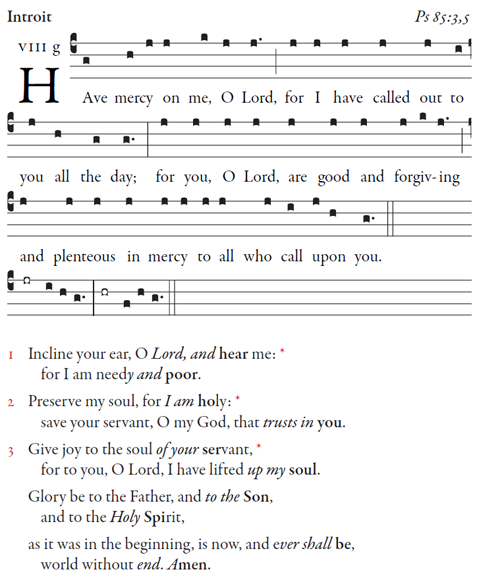In continuation with the ideas discussed in Jeffrey’s recent post “Toward the Singing of Propers”, here are two experimental samples of what such a simple parish resource for English propers might possibly look like. You can even sing them in Mass this weekend if you’d like!

The first sample is an engraving of the Introit, Offertory and Communion antiphons of the Graduale Romanum in English translation, set to simple Gregorian psalm tones. There are many reasons why a collection of propers using the Gregorian psalm tones would be an attractive solution, almost the “no-brainer” answer to the need for a simple parish resource for propers. After all, the Rossini propers, which were the Latin antiphons set to Gregorian tones, were very popular before the council, and the “Anglican Use Gradual” also uses a psalm tone approach and it is a very useful resource for many. Still, there are very real problems that are encountered in setting English texts to Gregorian psalm tones. The word accent and cadence patterns are very different in English than they are in Latin, for which the tones were composed, and 5 different people who set an English tone are likely to arrive at 5 different settings because of the challenges involved. Still this might be a reasonable solution to the problem of the average parish. Download it here.
The second sample is a similar yet different approach to solving the problem. In this case the same introit text is set in the first place using a melodic formula that is taken from the Gregorian modal and melodic vocabulary, yet is a sort of “hybrid” of a psalm tone (making great use of reciting pitches) and a through composed antiphon (with intonations, terminations and an overall melodic structure that is similar to these). The result is a melodic formula that is is a bit more sophisticated than a psalm tone, yet it is a formula that could be applied to virtually any English text (the formula in this example was composed as by Adam Bartlett and Fr. Columba Kelly, OSB). The main benefit to this approach for the beginning parish is that in learning a small set of melodies they will be able to sing a variety of, even all of the proper antiphons. A set of 8, 16, or even 24 of these melodic formulas could reflect the modality of the Gregorian propers, maintain a level of musical interest, retain simplicity, and could be used over and over again to make their use very simple for singers who are just beginning to sing the propers. Potential downfalls to this approach might be a perceived lack of “authenticity”, or a sense artificiality. Things to keep in mind are that the intention of the approach is to make the singing of propers as simple as possible for amateur parish singers. Download it here.
When we are talking about adapting the musical language of Gregorian chant to the English language there is always something that is going to be lost, and there is a hierarchy of values to be considered and taken into account. There is great opportunity, as we have recently heard from Msgr. Wadsworth, that there is a great opportunity for setting proper texts in a variety of styles. It remains to be seen as to which approach to the singing of the propers will be best for the aspiring parish. I think that there is absolutely an element of genius in the style of Gregorian chant that makes the weekly routine of singing new texts as smooth a process as possible, but I could be wrong. There are certainly many possibilities.
If you would like to participate in an An Experiment in Sacred Music Resource Production that explores these issues and is working toward solving the problem please visit the CMAA forum thread and get involved!
